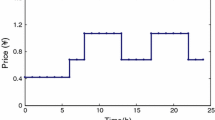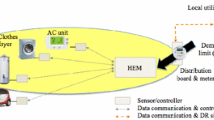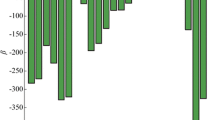Abstract
When consumers’ use of electricity is mainly driven by convenience, coincident demand occurs, resulting in electric load peaks. Consequently, the undesirable large gaps between peak and off-peak loads will adversely affect the system’s efficiency due to unused capacity during off-peak hours and extra ancillary generators required during peak hours. Demand response (DR) has long been proposed to reduce peak load by providing incentives to encourage consumers to shift their peak loads to off-peak periods. In most DR literature, incentive schemes are purely financial in assuming that cost is the only parameter to influence consumers’ load-shifting behavior. In this paper, we assume that in addition to cost, convenience of energy usage is also an important factor when consumers respond to DR programs. Hence, we use multi-attribute utility functions consisting of both cost and convenience factors to model consumer behavior on energy consumption for home appliances. The “convenience” herein is defined as being able to use an appliance during one’s preferred time window. A simulation model is developed to study a residential population consisting of heterogeneous households with varying preference of convenience over cost. We study the effects of time-of-use pricing structure on users’ utility-based load shifting behaviors and subsequently on system-wide performances such as peak to average ratio (PAR) and load variance (LV). We also describe a method of design of experiment (DOE) for determining an optimal time-of-use rate structure that minimizes both PAR and LV for the system.





Similar content being viewed by others
References
Azar, E., Menassa, C.C.: A decision framework for energy use reduction initiatives in commercial buildings. In: Proceedings of the 2011 Winter Simulation Conference, pp. 816–827. (2011)
Broda, C., Leibtag, E., Weinstein, D.E.: The role of prices in measuring the poors living standards. J. Econ. Perspect. 23(2), 77–97 (2009)
Chassin, D.P., Schneider, K., Gerkensmeyer, C.: GridLab-D: an open source environment of power systems modeling and simulation environment. Trans. Distrib. Conf. Expos. 1–5 (2008)
Chen, J., Taylor, J.E., Wei, H.: Toward a building occupant network agen-based model to simulate peer induced energy conservation behavior. In: Proceedings of the 2011 winter simulation conference, pp. 883–890 (2011)
Commonwealth of Kentucky.: Responsive pricing and smart metering pilot program annual report for Louisville Gas and Electric Company. Kentucky Public Service Commission, Case No. 2007–00117 (2011)
Conejo, A.J., Morales, J.M., Baringo, L.: Real-time demand response model. IEEE. Trans. Smart. Grid. 1(3), 236–242 (2010)
Daryanian, B., Bohn, R.E., Tabors, R.D.: Optimal demand-side response to electricity spot prices for storage-type customers. IEEE. Trans. Power. Syst. 4(3), 897–903 (1989)
Fahrioglu, M., Alvarado, F.L.: Designing incentive compatible contracts for effective demand management. IEEE. Trans. Power. Syst. 15(4), 1255–1260 (2000)
Keeney, R.L., Raiffa, H.: Decisions with multiple objectives: preferences and value tradeoffs. Cambridge University Press, Cambridge (1993)
Kelton, W.D., Smith, J.S., Sturrock, D.T., Verbraeck, A.: Simio and simulation: modeling, analysis. McGraw Hill Application, New York (2010)
Rate, Terms and Conditions for Furnishing Electric Service.: Louisville gas and electric company. Public Service Commission of Kentucky. Issued by authority of an order of the public service commission in case no. 2012–00222 (2013)
Maurer, L., Barroso, L.: Electricity auctions: an overview of efficient practices (World Bank Studies). World Bank Publications, (2011)
Mohsenian-Rad, A.H., Wong, V.W., Jatskevich, J., Schober, R.: Optimal and autonomous incentive-based energy consumption scheduling algorithm for smart grid innovative smart grid technologies (ISGT). IEEE. Trans. pp. 1–6 (2010)
Research Center, N.A.H.B., Inc.: Review of residential electrical energy use data, PATH (partnership for advancing technology in housing) (2001)
Ramchurn, S., Vytelingum, P., Rogers, A., Jennings, N.: Agent-based control for decentralized demand side management in the smart grid. The Tenth International Conference on Autonomous Agents and Multiagent Systems (AAMAS 2011), Taipei, Taiwan, pp. 5–12 (2011)
Ryan, B., Joiner, B., Ryan, T.: Minitab handbook. PWS-KENT, Boston (1992)
Samadi, P., Mohsenian-Rad, A., Schober, R., Wong, V., Jatskevich, J.: Optimal real-time pricing algorithm based on utility maximization for smart grid. The University of British Columbia, (2010)
Sensfus, F., Ragwitz, M., Genoese, M., Mst, D.: Agent-based simulation of electricity markets: a literature review. Energy. Stud. Rev. 15(2), 2 (2007)
Steeger, G., Barroso, L., Rebennack, S.: Optimal bidding strategies for hydro-electric producers: a literature survey. IEEE. Trans. Power. Syst. (2013)
Wallenius, J., Dyer, J.S., Fishburn, P.C., Steuer, R.E., Zionts, S., Deb, K.: Multiple criteria decision making, multiattribute utility theory: recent accomplishments and what lies ahead. Manag. Sci. 54(7), 1336–1349 (2008)
U.S.Census Bureau.: Census Summary File. Retrieved from http://www.census.gov/2010census/ (2010)
U.S. Energy Information Administration.: Annual Energy Outlook 2012. DOE/EIA-0383(2012)
Vuppala, S.K., Padmanabh, K., Bose, S.K., Paul, S.: Innovative smart grid technologies (ISGT), pp. 1–9 (2011)
Vytelingum, P., Voice, T.D., Ramchurn, S.D., Rogers, A., Jennings, N.R.: Agent-based micro-storage management for the smart grid. The ninth international conference on autonomous agents and multiagent systems (AAMAS 2010), Toronto, Canada, pp. 39–46 (2010)
Wood, G., Newborough, M.: Dynamic energy-consumption indicators for domestic appliances: environment, behaviour and design. Energy. Build. 35(8), 821–841 (2003)
Zhao, J., Kucuksari, S., Mazhari, E., Son, Y.: Integrated analysis of high-penetration PV and PHEV with energy storage and demand response. Appl. Energy. 112, 35–51 (2013)
Zhou, Z., Chan, W. K. V., Chow, J. H., Kotsan, S.: Duopoly electricity markets with accurate and inaccurate market goals. In: Proceedings of the 2009 Winter Simulation Conference (WSC), pp. 1569–1580 (2009)
Acknowledgments
This work is partly supported by the Kentucky Science and Technology Inc. under the grant KSEF-2808-RDE-016. In addition, research by the last author is in part supported by the National Science Foundation under grants ECCS-1232168.
Author information
Authors and Affiliations
Corresponding author
Rights and permissions
About this article
Cite this article
Khadgi, P., Bai, L., Evans, G. et al. A simulation model with multi-attribute utility functions for energy consumption scheduling in a smart grid. Energy Syst 6, 533–550 (2015). https://doi.org/10.1007/s12667-015-0153-9
Received:
Accepted:
Published:
Issue Date:
DOI: https://doi.org/10.1007/s12667-015-0153-9




